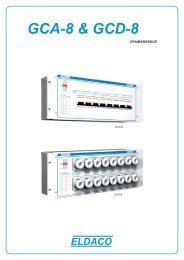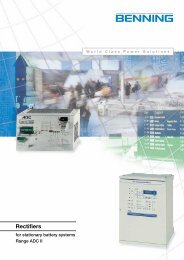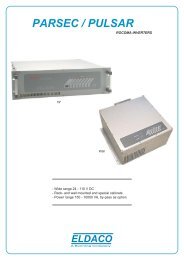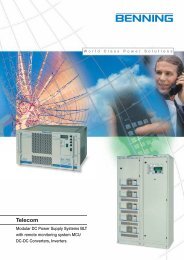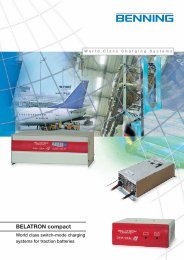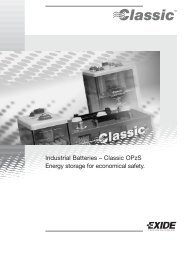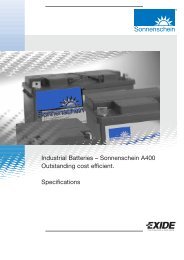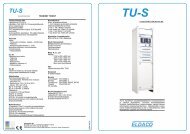Single and three phase inverters
Single and three phase inverters
Single and three phase inverters
Create successful ePaper yourself
Turn your PDF publications into a flip-book with our unique Google optimized e-Paper software.
World Class Power Solutions<br />
Auxiliary power supply<br />
Inverter operation<br />
Bypass operation<br />
Parallel operation<br />
Manuell bypass<br />
Overload<br />
Inverter failure<br />
Mains failure<br />
Battery voltage low<br />
LED Test<br />
<strong>Single</strong> <strong>and</strong> <strong>three</strong> <strong>phase</strong><br />
<strong>inverters</strong><br />
INVERTRONIC Range
2<br />
BENNING World Class Power Solutions<br />
INVERTRONIC<br />
disposed for highest security<br />
General<br />
The requirement for power supply reliability is growing, due<br />
to the increasing application of information <strong>and</strong> data carrier<br />
systems, text processing, automated production processes<br />
<strong>and</strong> complex data networks.<br />
Fig. 1: Possible Irregularities<br />
Irregularities due to loading of the public power supply by<br />
major users, peak-time use or by lightning strikes cannot be<br />
avoided.<br />
The result is:<br />
Mains voltage breaks, spikes <strong>and</strong> transients. (Fig. 1)<br />
Static <strong>inverters</strong> are being installed increasingly for loads<br />
who require AC voltages unaffected by interference on the<br />
mains e.g.<br />
• Data processing installations<br />
• Process control computers<br />
• Air safety installations<br />
• Signalling, alarm systems<br />
• Telecommunication systems<br />
• Power- <strong>and</strong> Substations<br />
Fig. 2: INVERTRONIC Inverter<br />
Design<br />
The exceptional characteristics of this inverter series results<br />
in very small dynamic voltage deviations even in the case of<br />
one hundred percent load changes.<br />
A combination of a 16-bit micro-controller <strong>and</strong> the latest<br />
power electronic is responsible for controlling <strong>and</strong> monitoring<br />
of all inverter <strong>and</strong> static switch functions with highest reliability.<br />
A static switch <strong>and</strong> a manual bypass switch are integrated<br />
in the unit.<br />
In the front of the cabinet there is a plastic foil keyboard with<br />
6 keys, 2 <strong>three</strong> coloured <strong>and</strong> 4 single coloured LED’s <strong>and</strong> a<br />
mimic diagram.
BENNING World Class Power Solutions<br />
INVERTRONIC with static bypass<br />
an uninterrupptible power supply<br />
3<br />
Function<br />
The static inverter not only has the task of supplying the connected<br />
consumers continuously <strong>and</strong> without interruption, but<br />
beyond that to also provide a clear improvement of the<br />
voltage <strong>and</strong> frequency quality in relation to the normal system.<br />
In normal operation the consumer is supplied by the<br />
inverter <strong>and</strong> output transformer route.<br />
Inverter<br />
The inverter power block changes DC voltage into a 3-<strong>phase</strong><br />
sinusoidal AC voltage with constant amplitude <strong>and</strong> stable frequency.<br />
The output voltage is independent of line disturbances<br />
or power failures.<br />
The unit works with an IGBT inverter bridge with pulse width<br />
modulation having a high efficiency in the partial load range<br />
as well as achieving a low distortion factor at non linear load.<br />
In the event of mains interruption or failure, the battery connected<br />
to the DC input is brought in automatically <strong>and</strong> without<br />
interruption to supply current. If the battery becomes<br />
discharged this is reported. If the battery discharge limit is<br />
exceeded, the installation automatically turns off <strong>and</strong> a warning<br />
is given shortly before the discharged voltage limit is<br />
reached.<br />
Automatic change-over of the load to the bypass mains or<br />
a suitable spare installation occurs if the supply from the inverter<br />
falls outside the preset tolerances.<br />
Static Bypass<br />
The static bypass consists of a semiconductor switch in the<br />
bypass circuit. In the case of an appropriate deviation of the<br />
output voltage from the desired values, it switches the connected<br />
load automatically <strong>and</strong> without interruption to the<br />
mains.<br />
The static bypass component of the installation facilitates<br />
uninterrupted change-over to direct mains supply (bypass<br />
mains), keeping the specified tolerances. The change-over<br />
can be initiated manually or automatically by a control signal.<br />
The µP monitoring is autonomous <strong>and</strong> prevents incorrect<br />
operation of the installation <strong>and</strong> any illogical switching functions<br />
of the static bypass. Thus, for example, an uninterrupted<br />
change-over, whether automatic or manual, is only possible<br />
when the voltage, frequency <strong>and</strong> <strong>phase</strong> conditions of the<br />
inverter are synchronised with the bypass mains. Mains<br />
frequency deviations, which lie outside the preset tolerances<br />
cause blocking of the change-over, or if the inverter fails, a<br />
change-over with an interruption.<br />
A change back can only occur to a functioning inverter, <strong>and</strong> is<br />
in everycase uninterrupted even if the mains should fail on a<br />
test change-over.<br />
The static bypass has an overload capability of 150 % for<br />
10 min. <strong>and</strong> 1000 % for 100 ms.<br />
After the presence of an overload or a short-circuit, it automatically<br />
resets the load to the inverter, if normal operation is<br />
possible.<br />
The static bypass consists of a microprocessor-controlled<br />
anti parallel thyristor block. It can be activated manually with<br />
a push button, in order to test the change-over. The changeover<br />
from inverter to the mains <strong>and</strong> back takes place in a<br />
synchronised operation without a break.
4<br />
INVERTRONIC<br />
BENNING World Class Power Solutions<br />
multi utilities<br />
Internal manual bypass<br />
Each inverter is equipped with a maintenance bypass with<br />
manually operated switch. When operated, the Inverter is<br />
completely disconnected from the load. The supply to the<br />
load is now directly from the mains via the manual bypass.<br />
Instrumentation<br />
A background-lit 4 x 20 alphanumeric liquid Crystal display<br />
(LCD), which is operated by push buttons, is built into<br />
the front door. This unit indicates the following specified<br />
measured values:<br />
Inverter: · input voltage<br />
· input current<br />
· output voltage,<br />
· output current of each <strong>phase</strong> <strong>and</strong> frequency<br />
· apparent power<br />
· real power<br />
Bypass:<br />
· input voltage,<br />
· input current of each <strong>phase</strong> <strong>and</strong> frequency<br />
An event recorder stores each occurring event (push button<br />
operation, switching events <strong>and</strong> error) with date <strong>and</strong> time. Up<br />
to 1199 entries can be stored.<br />
Fig. 3: Interior view<br />
Front Panel<br />
The operation of the inverter is made by a plastic foil keyboard<br />
with 6 keys, 2 <strong>three</strong> coloured <strong>and</strong> 4 single coloured<br />
LED’s. There is a mimic diagram on the operating section.<br />
The operating condition <strong>and</strong> any operational disturbances are<br />
represented by the multi colour LED’s.<br />
There is a 4-line, 80-digit LC display in the operating section<br />
for reading information <strong>and</strong>/or for clear guidance by the<br />
menu. Control of the operating section takes place via the<br />
display controller, which communicates over the CAN bus<br />
with the controller board.<br />
In addition, the most important operating <strong>and</strong> fault signals<br />
are indicated by 13 single LED’s.<br />
Parallel Operation<br />
For redundancy or increased output power, up to eight<br />
INVERTRONIC units can be connected in parallel, operating in<br />
an active load-sharing mode.<br />
Half load parallel operation is achieved using two separate<br />
bus bars, connected with a coupling switch. The state of the<br />
coupling switch is relayed to the microprocessor, via an<br />
auxiliary contact.<br />
Option<br />
For power plant applications where higher than normal fault<br />
clearing current is required, it is possible to specify an option<br />
for 4 x I nominal system output. Depending on the output<br />
power, a bigger cabinet may be required.<br />
Fig. 4:<br />
Front Panel<br />
INVERTRONIC<br />
Auxiliary power supply<br />
Inverter operation<br />
Bypass operation<br />
Parallel operation<br />
Manuell bypass<br />
Overload<br />
Inverter failure<br />
Mains failure<br />
Battery voltage low<br />
140 %<br />
120 %<br />
100 %<br />
80 %<br />
60 %<br />
Fig. 5:<br />
Available inverter<br />
apparent<br />
output power<br />
depending on<br />
power factor<br />
40 %<br />
20 %<br />
LED Test<br />
0% 0 0,2 0,4 0,6 0,8 1 0,8 0,6 0,4 0,2 0<br />
leading<br />
power factor<br />
lagging
5<br />
BENNING World Class Power Solutions<br />
INVERTRONIC<br />
all-purpose<br />
Technical Data<br />
<strong>Single</strong> <strong>phase</strong> inverter INVERTRONIC Range - DIN Type: G 220 E 230/...../2 rfg-WEG....<br />
Nominal output power at cos. phi 0,8: [kVA] 30 40 50 60 80 100 120<br />
Inverter input<br />
Input voltage: [V] 220<br />
Input voltage range: [%] -15 to +20<br />
Permitted overlaid AC: [%] < 5 eff.<br />
AC current feedback on DC input: [%] < 10 eff.<br />
Switch on current:<br />
< I-Nom.<br />
Input current at cos phi 0,8<br />
<strong>and</strong> nominal input voltage:<br />
[A] 118 156 196 233 307 383 460<br />
DC power at battery operation: [kW] 26 34,4 43 51,1 67,4 84,2 101<br />
Efficiency at nominal load: [%] 92 93 93 94 95 95 95<br />
Inverter output<br />
Output voltage: [V] 1/N 230 PE<br />
Adjustment range of output voltage: [%] ± 5<br />
Voltage tolerance<br />
- static: ± 1%<br />
- dynamic: ± 4% for 100% load change<br />
Regulation time: [msec] ≤ 10<br />
Nominal output current each <strong>phase</strong>: [A] 130 173 217 260 347 434 521<br />
Non-linear load: Crestfaktor ≤ 3<br />
Motor load:<br />
100% permitted (note inrush current)<br />
Overload behaviour:<br />
50% for 60 sec.<br />
25% for 10 min.<br />
10% for 20 min.<br />
Short-circuit behaviour:<br />
Short circuit proof<br />
Short circuit current:<br />
3 x I - nom for 3 sec.<br />
Output frequency: [Hz] 50 (60) ± 0,1% quartz or mains synchronised<br />
Synchronisation range: [Hz] 50 (60) ± 3%<br />
Wave form:<br />
Sine wave<br />
Distortion factor (acc. EN 62040):<br />
≤ 0,5 with linear load<br />
[%]<br />
≤ 5 with non linear load<br />
Static bypass<br />
Overload behaviour:<br />
150% for 10 min.<br />
500% for 100 msec.<br />
Transfer time:<br />
- at inverter failure [msec] < 1 (uninterruptible)<br />
- at overload or manual activation [msec] < 1 (uninterruptible)<br />
Dimensions:<br />
- Height [mm] 2000 (2200*) 2000 (2200*)<br />
- Width [mm] 800 1600<br />
- Depth [mm] 800 800<br />
(* 2200 mm height is also possible)
BENNING World Class Power Solutions<br />
INVERTRONIC<br />
all-purpose<br />
6<br />
Technical Data<br />
Three Phase Inverter INVERTRONIC Range - DIN Type: G 220 D 400/...../2 rfg-WDG....<br />
Nominal output power at cos. phi 0,8: [kVA] 30 40 50 60 80 100 120<br />
Inverter input<br />
Input voltage: [V] 220<br />
Input voltage range: [%] -15 to +20<br />
Permitted overlaid AC: [%] < 5 eff.<br />
AC current feedback on DC input: [%] < 5 eff.<br />
Switch on current:<br />
< I-Nom.<br />
Input current at cos phi 0,8<br />
<strong>and</strong> nominal input voltage:<br />
[A] 116 154 193 233 307 383 460<br />
DC power at battery operation: [kW] 25,5 33,9 42,5 51,1 67,4 84,2 101<br />
Efficiency at nominal load: [%] 94 94 94 95 95 95 95<br />
Inverter output<br />
Output voltage: [V] 400/ 230 3-ph., N, PE<br />
Adjustment range of output voltage: [%] ± 5<br />
Voltage tolerance<br />
- static: ± 1%<br />
- dynamic: ± 4% for 100% load change<br />
- asymmetric load: ± 2% at 100% of centre load<br />
Regulation time: [msec] ≤ 10<br />
Nominal output current each <strong>phase</strong>: [A] 43,3 57,8 72,2 86,7 115 144 172<br />
Non-linear load: Crestfaktor ≤ 3<br />
Motor load:<br />
100% permitted (note inrush current)<br />
Overload behaviour:<br />
50% for 60 sec.<br />
25% for 10 min.<br />
10% for 20 min.<br />
Short-circuit behaviour:<br />
Short circuit proof<br />
Short circuit current:<br />
single <strong>phase</strong> 3,5 x I - nom for 3 sec.;<br />
<strong>three</strong> <strong>phase</strong> 2 x I - nom for 3 sec.<br />
Output frequency: [Hz] 50 (60) ± 0,1% quartz or mains synchronised<br />
Synchronisation range: [Hz] 50 (60) ± 3%<br />
Wave form:<br />
Sine wave<br />
Distortion factor (acc. EN 62040):<br />
≤ 1 with linear load<br />
[%]<br />
≤ 5 with non linear load<br />
Static bypass<br />
Overload behaviour:<br />
150% for 10 min.<br />
1000% for 100 msec.<br />
Transfer time:<br />
- at inverter failure [msec] < 1 (uninterruptible)<br />
- at overload or manual activation [msec] < 1 (uninterruptible)<br />
Dimensions:<br />
- Height [mm] 2000 (2200*)<br />
- Width [mm] 800<br />
- Depth [mm] 800<br />
(* 2200 mm height is also possible)
BENNING World Class Power Solutions<br />
INVERTRONIC<br />
Generel data<br />
7<br />
Generel datas for WEG <strong>and</strong> WDG<br />
Radio interference: In accordance EN 50091-2<br />
Transducer:<br />
1 x 0 respectively 4 to 20 mA free programmble<br />
Relay outputs:<br />
6 x volt free change over contacts<br />
Interfaces:<br />
1 x RS232 <strong>and</strong> RS485, each with MODBus protocol<br />
Permitted power factor:<br />
0,0 ind. - 0,0 cap.,<br />
for deviations of cos phi 0,8 ind.<br />
power reduction is needed only via 1 to the cap. range (see figure 5)<br />
Noise level with 1 m distance: [dB(A)] app. 65<br />
Cooling:<br />
Forced cooling with redundant, speed controlled fans<br />
Permitted ambient temp.: [°C] 0 to +40<br />
Permitted climatic data:<br />
temperate climate<br />
Humidity class: Class F, DIN 40040<br />
Permitted installation height<br />
at nominal load:<br />
[m]<br />
1000 above sea level<br />
Protection degree: IP 20 in accordance DIN 40050<br />
Painting:<br />
RAL 7035, structural paint<br />
Other options e.g.:<br />
Profibus DP interface connected to RS232,<br />
Bypass transformer (additional cabinet),<br />
higher protection IP,<br />
6 additional alarm relay contacts (free programable),<br />
additional RS232 <strong>and</strong> RS485 interfaces<br />
(additional options on request)<br />
power section with controller<br />
fan unit (speed controlled)<br />
internal protection<br />
circuit breakers <strong>and</strong> manual bypass<br />
fused DC breaker<br />
AC terminals<br />
fan unit (speed controlled)
BENNING World Class Power Solutions<br />
www.benning.de<br />
BENNING worldwide<br />
Austria<br />
Benning GmbH Elektrotechnik und Elektronik<br />
Eduard-Klinger-Str. 9<br />
A-3423 St. Andrä-Wördern<br />
Tel. 0 22 42 / 3 24 16-0<br />
Fax 0 22 42 / 3 24 23<br />
E-Mail: info@benning.at<br />
Irel<strong>and</strong><br />
Theo Benning GmbH<br />
North Industrial Estate<br />
Whitemill North<br />
IRE-Wexford / Rep. Irel<strong>and</strong><br />
Tel. 0 53 / 76 90 0<br />
Fax 053/41841<br />
E-Mail: benning@benning.ie<br />
South East Asia<br />
Benning Power Electronics Pte Ltd<br />
1, Kaki Bukit View<br />
# 05-03/04 Techview<br />
SGP-Singapore 415941<br />
Tel. (65) 6844 3133<br />
Fax (65) 6844 3279<br />
E-Mail: sales@benning.com.sg<br />
Belgium<br />
Benning Belgium<br />
Power Electronics<br />
Z. 2 Essenestraat 16<br />
B-1740 Ternat<br />
Tel. 02 / 58 287 85<br />
Fax 02 / 58 287 69<br />
E-Mail: info@benning.be<br />
Italy<br />
Benning Conversione di Energia S.r.l.<br />
Via E. Mattei, 7<br />
I-40138 Bologna<br />
Tel. 0 51 / 53 19 55<br />
Fax 0 51 / 53 09 23<br />
E-Mail: benning.energia@libero.it<br />
Sweden<br />
Eldaco AB<br />
Box 990, Hovslagarev. 3B<br />
S-19129 Sollentuna<br />
Tel. 08 / 6239500<br />
Fax 08 / 969772<br />
E-Mail: power@eldaco.se<br />
Czech Republic<br />
Benning CR s.r.o.<br />
Zahradní ul. 894<br />
CZ-293 06 Kosmonosy<br />
(Mladá Boleslav)<br />
Tel. 326721003<br />
Fax 3 26 72 25 33<br />
E-Mail: benning@benning.cz<br />
Netherl<strong>and</strong>s<br />
Benning NL<br />
Power Electronics<br />
Peppelkade 42<br />
NL-3992 AK Houten<br />
Tel. 030/6346010<br />
Fax 0 30 / 6 34 60 20<br />
E-Mail: info@benning.nl<br />
Switzerl<strong>and</strong><br />
Benning Power Electronics GmbH<br />
Industriestrasse 6<br />
CH-8305 Dietlikon<br />
Tel. 01/ 8057575<br />
Fax 01/ 8057580<br />
E-Mail: info@benning.ch<br />
France<br />
Benning Conversion d’énergie<br />
43, avenue Winston Churchill<br />
B.P. 418<br />
F-27404 Louviers Cedex<br />
Tél. 0 / 2.32.25.23.94<br />
Fax 0 / 2.32.25.08.64<br />
E-Mail: info@benning.fr<br />
Pol<strong>and</strong><br />
Benning Power Electronics Sp.z.o.o.<br />
Korczunkowa 30<br />
PL-05-503 Glosków<br />
Tel. 0 22 / 7 57 84 53 / 7 57 36 68-70<br />
Fax 0 22 / 7 57 84 52<br />
E-Mail: biuro@benning.biz<br />
Spain<br />
Benning Conversión de Energía S.A.<br />
C/Pico de Santa Catalina 2<br />
Pol. Ind. Los Linares<br />
E-28970 Humanes, Madrid<br />
Tel. 91/ 6048110<br />
Fax 91/ 6048402<br />
E-Mail: benning@benning.es<br />
ISO 14001<br />
Germany<br />
Theo Benning<br />
Elektrotechnik und Elektronik GmbH & Co.KG<br />
Münsterstr. 135-137<br />
D-46397 Bocholt<br />
Tel. 0 28 71/ 93-0<br />
Fax 02871/93297<br />
E-Mail: info@benning.de<br />
Great-Britain<br />
Benning Power Electronics (UK) Ltd.<br />
Oakley House<br />
Hogwood Lane<br />
Finchampstead<br />
GB-Berkshire<br />
RG 40 4QW<br />
Tel. 0118 9731506<br />
Fax 0118 9731508<br />
E-Mail: info@benninguk.com<br />
Hungary<br />
Benning Kft.<br />
Power Electronics<br />
Rákóczi út 262<br />
H-2541 Lábatlan<br />
Tel. 033/507600<br />
Fax 033/507601<br />
E-Mail: benning@vnet.hu<br />
P. R. of China<br />
Benning V. GmbH<br />
Shanghai Repr. Office<br />
728 Xinhua Road, Rm. 1012<br />
Union Developing Building<br />
PRC-200 052 Shanghai<br />
Tel. 086 21 62838184<br />
Fax 086 21 62838164<br />
E-Mail: benning@sh163.net<br />
Russian Federation<br />
OOO Benning Power Electronics<br />
Scholkovskoje Chaussee, 5<br />
RF-105122 Moscow<br />
Tel. 095/9676850<br />
Fax 0 95 / 9 67 68 51<br />
E-Mail: benning@benning.ru<br />
Slovakia<br />
Benning Slovensko, s.r.o.<br />
Kukuričná 17<br />
SK-83103 Bratislava<br />
Tel. 02 / 44459942<br />
Fax 02 / 44455005<br />
E-Mail: benning@internet.sk<br />
Ukraine<br />
Benning<br />
ul. Solomenskaja, 3B<br />
UA-03110 Kiew<br />
Tel. 044 / 246 10 25<br />
Fax 044 / 248 92 36<br />
E-Mail: benning@benning.com.ua<br />
U.S.A.<br />
Benning Power Electronics, Inc.<br />
11120 Grader Street<br />
USA-Dallas, TX 75238<br />
Tel. 214 5531444<br />
Fax 214 5531355<br />
E-Mail: sales@benning.us<br />
784335.01 GB 02/2005 paus Design & Medien, Bocholt Subject to alterations. Printed on chlorine free paper.



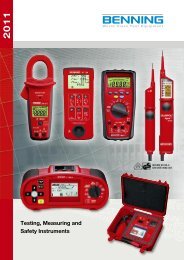
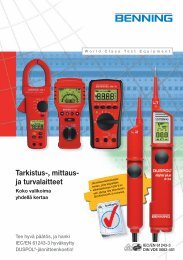
![2008-03-03 Ãbersichten [de-en-ru-fr].indd](https://img.yumpu.com/27509296/1/184x260/2008-03-03-abersichten-de-en-ru-frindd.jpg?quality=85)
